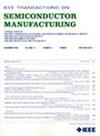半导体单晶-硅生长的结构损失实时自动检测与停止规则
IF 2.3
3区 工程技术
Q2 ENGINEERING, ELECTRICAL & ELECTRONIC
引用次数: 0
摘要
在单晶硅生长(SCSG)过程中出现 "结构损失 "缺陷是半导体制造中的一个重要问题。当结构损失发生时,就意味着单晶形成的质量偏离了预期,从而需要停止生长过程。目前,还缺乏学术文献来探讨如何确定最佳停止时间,以便在出现在线缺陷时及时停止工艺。我们的研究通过解决 SCSG 过程中的这一空白,特别是关注方向和......,做出了重大贡献。这项研究利用了 YOLO-v7 先进的人工智能和创新方法。这些方法包括通过结构损失的全面定义和新颖的标记技术对晶体错向特征进行精确标注,通过稳健的设计识别最佳超参数,以及实施有效的停止规则机制。通过实施停止时间转移,在决策方面取得了重大进展,在平均不到 3 分钟(标准误差为 0.3 分钟)和不到 5 分钟(标准误差为 0.5 分钟)的时间内终止了取向 SCSG 过程。这些令人鼓舞的结果表明,所提出的方法有能力替代人工检查,为这一特定领域开辟了新的前景。本文章由计算机程序翻译,如有差异,请以英文原文为准。
A Real-Time Automatic Structural-Loss Detection and Stopping Rule of Semiconductor Single-Crystal-Silicon-Growth <100> and <111>
The occurrence of the “structural-loss” defect during single-crystal silicon growth (SCSG) is a significant issue in semiconductor manufacturing. When structural-loss occurs, it signifies a deviation from the desired quality of single-crystal formation, leading to the need to halt the growth process. Currently, there is a lack of scholarly literature addressing the determination of an optimal stopping time to promptly halt the process upon the occurrence of the defect on-line. Our research makes a substantial contribution by addressing this gap in the SCSG process, specifically focusing on orientations <100> and <111>. The study utilizes advanced AI with YOLO-v7 and innovative approaches. These include precise annotation of crystal misorientation features through a comprehensive definition of structural-loss and novel labeling techniques, identification of optimal hyper-parameters through a robust design, and the implementation of effective stopping rule mechanisms. Significant progress has been achieved in decision-making through the implementation of the stoping time shift to terminate the SCSG process within an average of less than 3 minutes for <100> orientations (with a standard error of 0.3 minutes) and less than 5 minutes for <111> orientations (with a standard error of 0.5 minutes). The promising results indicate that the proposed approaches have the capability to substitute manual inspections, opening up possibilities for new perspectives in this particular field.
求助全文
通过发布文献求助,成功后即可免费获取论文全文。
去求助
来源期刊

IEEE Transactions on Semiconductor Manufacturing
工程技术-工程:电子与电气
CiteScore
5.20
自引率
11.10%
发文量
101
审稿时长
3.3 months
期刊介绍:
The IEEE Transactions on Semiconductor Manufacturing addresses the challenging problems of manufacturing complex microelectronic components, especially very large scale integrated circuits (VLSI). Manufacturing these products requires precision micropatterning, precise control of materials properties, ultraclean work environments, and complex interactions of chemical, physical, electrical and mechanical processes.
 求助内容:
求助内容: 应助结果提醒方式:
应助结果提醒方式:


